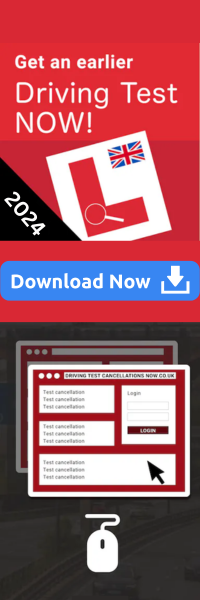Regarding the practical driving test, learners can adopt numerous strategies to maximise their chances of passing, such as learning the UK driving test routes.
For instance, enlisting a local driving instructor can ensure you’re well-acquainted with the local area.
Beyond lessons, practice sessions with friends and family can bolster your driving skills.
But have you considered understanding the UK driving test routes?
In this article, we’ll guide you through the ins and outs of UK driving test routes—what they entail, where to find them, and their importance in securing a pass on your driving test.
The Basics of UK Driving Test Routes
In a driving test, examiners don’t whimsically decide the route to take around the test centre.
Instead, they follow a specified path designed by the DVSA.
Each test centre will typically have at least a dozen potential UK driving test routes—the examiner is provided with a random one for each test.
These UK driving test routes commence from the test centre, gradually extending to diverse areas to incorporate various road types and traffic conditions.
Here are some elements you’re likely to encounter on your test route:
Residential and city areas: This gauges your ability to navigate different traffic and speed conditions confidently and safely.
Difficult local road types: These could include intricate junctions, one-way systems, and multi-lane roundabouts.
Local dual carriageways: This tests your ability to adapt to high-speed roads.
While these UK driving test routes might slightly differ, they all aim to include the above components, testing a learner’s readiness to drive unsupervised.

You’ll follow the examiner’s instructions for approximately 20 minutes during your actual driving test.
After this, you’ll progress to the independent driving section, following the test route using directions from a sat nav.
(Unless you’re in the 20% of drivers asked to follow traffic signs instead.)
To better understand the structure of the practical, please refer to our guide to what happens in the driving test.
Should you deviate from your test route, the examiner will provide verbal directions to bring you back on track.
Therefore, don’t panic if your memory or test day nerves falter!
Discovering Your UK Driving Test Routes
Let’s not sugarcoat it—finding your official UK driving test routes is next to impossible.
Routes used to be accessible online until 2010, when the DVSA stopped publishing them.
This decision was aimed at aiding learner drivers.
Before this change, some instructors only trained their students on official routes, expecting them to memorise as much as possible.
This approach had detrimental impacts on learners.
Most of the driving test was spent recalling the next road on the route instead of focusing on road conditions.
Anxiety ensued if the examiner deviated from the memorised routes due to closures or unexpected congestion, causing delays in returning to the test centre.

A lack of exposure to any road types or features not included in their test centre’s routes, such as multi-lane roundabouts, one-way systems, and other challenging junctions.
UK driving test routes do not mirror real-life driving conditions.
Sticking to them means limiting yourself to a specific range of road types and conditions within your local area.
Once you pass your test and venture further afield unsupervised, you may be overwhelmed when encountering an unfamiliar road type.
By discontinuing the publication of test routes, the DVSA has made the driving test more realistic.
This step encourages instructors to equip learners with the skills and confidence to drive safely and independently, regardless of location.
Despite this, a quick online search for UK driving test routes will yield numerous sites claiming to offer them for a fee.
Beware!
Most of these routes are either outdated or completely fabricated.
I can assist if you’re still intrigued by UK driving test routes.
I provide essential test guides for all practical test centres we cover.
These guides offer sample UK driving test routes for download.
To avail of this, visit our practical test centres page and select your test centre.
However, remember that these routes are unofficial and should only be used as a rough guide.
The Truth about UK Driving Test Routes
As hard as it may be to accept, UK driving test routes aren’t the secret to passing your test.
It wouldn’t guarantee a pass even if you could access your local test centre’s official routes.
If you’re sceptical, let’s delve into a few reasons for this.
Change is the only constant.
Consider that you’ve memorised all test routes used at your local test centre.
Despite your preparedness, the examiner might unexpectedly ask you to turn onto a road not on your route due to roadworks or other unforeseen events.
Instantly, your confidence is shattered.
Road and traffic conditions are dynamic, often requiring examiners to improvise to ensure the driving test doesn’t exceed the allotted time.
Thus, UK driving test routes might seem rigid on paper, but they’re more flexible in real-life driving.
Maintain the right focus.
There’s a lot to process during the driving test—you must heed your examiner’s instructions, follow sat nav directions, and remain alert to your surroundings to spot potential hazards.
Adding test routes to this mix can lead to chaos.
If your entire focus is on remembering the next turn, can you spot hazards?
Probably not.
This lack of focus can lead to driving test faults and serious accidents!
Learning to drive, not memorise
The primary goal of learning to drive isn’t merely to pass the test but to become a safe and confident driver capable of handling diverse road and traffic conditions.
If your lessons revolve solely around driving on test routes, you undermine your learning experience.
While familiarity with your local area is essential, it shouldn’t limit you to the same roads.
Being comfortable while driving in unfamiliar areas is a crucial skill. If your driving skills are honed, the unfamiliarity of the roads shouldn’t matter.

Preparing for Your Driving Test
Focus on taking driving lessons with a local, DVSA-approved instructor instead of obsessing over UK driving test routes.
A competent instructor will guide you around the roads favoured by driving examiners—gained from accompanying learners on their tests—without restricting you to your local area.
They’ll also help you test your skills on unfamiliar roads that won’t appear on your practical, ensuring you’re prepared for any situation post-test.
Learning to Drive
During your lessons, ensure that your instructor covers all the types of roads and junctions you might encounter during your driving test and after passing.
This includes quiet residential streets, busy high-speed roads, roundabouts, junctions, and crossroads.
Aim to be as well-rounded as possible with your driving skills.
Next, make sure to learn how to follow directions from a sat nav.
This is a key part of the independent driving section of the test and one that many learner drivers find tricky.
Take the time to practice with a sat nav during your lessons or even when practising with a family member or friend.
Also, take the time to familiarise yourself with the ‘Show Me, Tell Me’ questions.
These are questions that your examiner will ask you at the beginning and during your test about car safety and maintenance.
Knowing these questions well can give you a great head start in your driving test.
Lastly, always be prepared for any surprises.
Your examiner might take you on a route that’s not usually taken, or there might be unexpected road works or traffic.
Always stay calm and use the skills you’ve learned during your lessons to handle the situation.

Conclusion: Don’t memorise UK driving test routes!
While knowing the UK driving test routes might seem like an advantage, the truth is, it’s far more important to be a safe, confident, and versatile driver.
Driving isn’t about memorising routes—it’s about adapting to different road conditions and situations.
Rather than trying to memorise driving test routes, focus on improving your driving skills, learning how to handle different road types and conditions, and, most importantly, becoming a safe driver.
As we wrap up, let’s revisit the critical message from the DVSA: the purpose of the driving test is to ensure you can drive safely in various road and traffic conditions, understand The Highway Code, and can demonstrate this through your driving skills.
Hence, your ultimate goal should be to be so proficient at driving that you can handle any route confidently and safely—not just the ones in your local area.
Here’s wishing you the best of luck on your driving journey!
Drive safe.







0 Comments